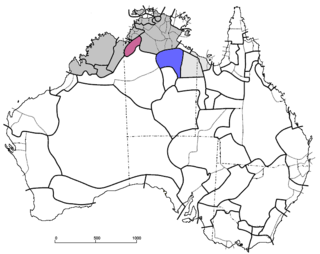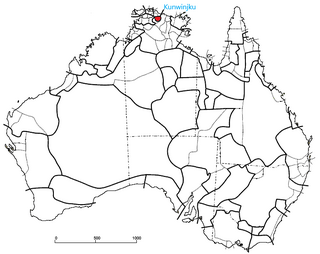The Ramindjeri or Raminjeri people were an Aboriginal Australian people forming part of the Kukabrak grouping now otherwise known as the Ngarrindjeri people. They were the most westerly Ngarrindjeri, living in the area around Encounter Bay and Goolwa in southern South Australia, including Victor Harbor and Port Elliot. In modern native title actions a much more extensive territory has been claimed.

The Mirndi or Mindi languages are an Australian language family spoken in the Northern Territory of Australia. The family consists of two sub-groups and an isolate branch: the Yirram languages, and the Ngurlun languages and Jingulu language some 200 km farther to the southeast, separated by the Ngumpin languages. The primary difference between the two sub-groups is that while the Yirram languages are all prefixing like other non-Pama–Nyungan languages, the Ngurlun languages are all suffixing like most Pama–Nyungan languages.

The Yirram or Jaminjungan languages, also known as Western Mirndi, are a branch of the Mirndi languages spoken around the Victoria River in the Northern Territory of Australia. The name of these languages is derived from the dual clitic which is "yirram" in each of the languages.
Jaminjung is a moribund Australian language spoken around the Victoria River in the Northern Territory of Australia. There seems to be a steady increase in the number of speakers of the language with very few people speaking the language in 1967, about 30 speakers in 1991, and between 50 and 150 speakers in 2000.

The Kunwinjku people are an Australian Aboriginal people, one of several groups within the Bininj people, who live around West Arnhem Land to the east of Darwin, Northern Territory. Kunwinjku people generally refer to themselves as "Bininj" in much the same way that Yolŋu people refer to themselves as "Yolŋu".

The Nyikina people are an Aboriginal Australian people of the Kimberley region of Western Australia.
The Erawirung people, also known as Yirau, Juju and other names, were an Aboriginal Australian people whose traditional territory was located in what is today the Riverland of South Australia. They consisted of sub-groups or clans, including Jeraruk, Rankbirit and Wilu, and have been referred to as Meru people, which was a larger grouping which could also include the Ngawait and Ngaiawang peoples.
The Maraura or Marrawarra people are an Aboriginal group whose traditional lands are located in Far West New South Wales and South Australia, Australia.
The Bininj are an Aboriginal Australian people of Western Arnhem land in the Northern Territory. The sub-groups of Bininj are sometimes referred to by the various language dialects spoken in the region, that is, the group of dialects known as Bininj Kunwok; so the people may be named the Kunwinjku, Kuninjku, Kundjeyhmi (Gundjeihmi), Manyallaluk Mayali, Kundedjnjenghmi and Kune groups.
The Jarildekald people, also known as Yarilde or Yaralde, are an Aboriginal Australian people of South Australia originating on the eastern side of Lake Alexandrina and the Murray River.
The Ngintait, or Ngindadj, are an Australian Aboriginal peoples of the northwest corner of the state of Victoria, and partly in South Australia. 9 people, all of one family, claim descent from the tribe, which was dispersed in the 19th century.
The Bodaruwitj, also rendered Bedaruwidj or Potaruwutj, and referred to in some early sources as the Tatiara, are an Aboriginal Australian people of the state of South Australia. David Horton believed they were the group his sources referred to as the Bindjali people. Austlang refers to Bindjali / Bodaruwitj as alternative names for the same language.
Keiadjara, also rendered Kiyajarra, were an Aboriginal Australian people of the Pilbara region of Western Australia.
The Jamindjung, also spelt Djamindjung, are an indigenous Australian people of the Northern Territory.
The Ngaliwurru are an indigenous Australian people of the Northern Territory.
The Watta were an indigenous Australian people of the Northern Territory.

The Wirangu are an Aboriginal Australian people of the Western coastal region of South Australia.
The Gungorogone are an indigenous Australian people of the Northern Territory.
The Yunggor were an Aboriginal Australian people of the Northern Territory.
The Wandjira were an indigenous Australian people of the Northern Territory.